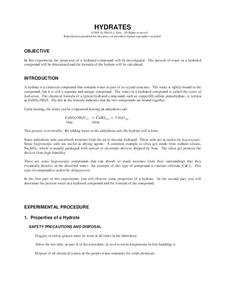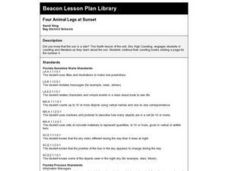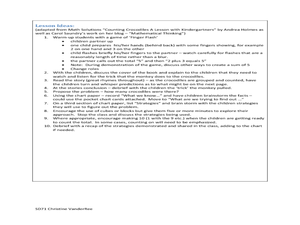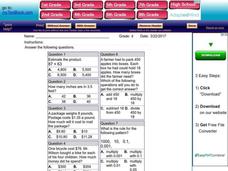Baylor College
Bio Build-up
Trace pollutants through the environment in the seventh lesson of this series on the science of food. Looking at a picture of the plants and animals in an aquatic ecosystem, learners use dot stickers to represent harmful chemicals as...
Positively Autism
"Share the Road" Folder/Shoebox Games
Introduce the importance of sharing and taking turns with your learners through a hands-on learning experience involving toy cars! Here you'll find activity instructions and printables to support your "Share the Road" collaborative...
Florida Center for Reading Research
Phonics: Varient Correspondances, Silent "e" Changes
Engage early readers in a silent e activity to help them understand the changes the letter can make to a simple word. With the provided cards, learners read and write each word as it appears without the silent e. Then they read and write...
Mathematics Vision Project
Module 4: Linear and Exponential Functions
Sequences and series are traditionally thought of as topics for the pre-calculus or calculus class, when learners are figuring out how to develop limits. But this unit uses patterns and slopes of linear functions in unique ways...
Chymist
Hydrates
What occurs when a hydrate is heated? Lead your class in exploring the answer to this question as they investigate the properties of a hydrated compound. They heat copper(II) sulfate pentahydrate and evaporate the water...
Science Matters
Formative Assessment #2
Learners work collaboratively to predict what life would be like as an Arctic Hare. Teams go on a hunt where scholars role play an owl, white hares, and gray hares. Independently, pupils record their findings and reflect on their...
Seussville
A Classic in 236 Words
Get in the reading spirit on Read Across America Day while celebrating Dr. Seuss' birthday with four printable worksheet activities. Included is a word search using story character's names, a quiz to test how many Dr. Seuss titles you've...
EngageNY
Exponential Notation
Exponentially increase your pupils' understanding of exponents with an activity that asks them to explore the meaning of exponential notation. Scholars learn how to use exponential notation and understand its necessity. They use negative...
EngageNY
End-of-Module Assessment Task: Grade 7 Mathematics Module 5
Show learners how to use simulations and random sampling to reach conclusions with the last resource in a 25-part series. The assessment contains three scenarios, each with several parts, and covers comparing populations using...
Curated OER
Tattling and Correcting Cards and Panels
When is it okay to correct others and report their mistakes? Here you'll find a tattling and correcting game in which learners draw cards describing a variety of infraction scenarios, and then ask questions to determine whether it is...
Physics Classroom
Position-Time Graphs - Conceptual Analysis
Increasingly, colleges and employers want applicants with strong conceptual analysis skills, so give them some practice! Applying these skills to position-time graphs encourages synthesis of knowledge. To complete an installment of a...
Curated OER
Worksheet 8 - Vectors
In this vector worksheet, students find the area of a parallelogram spanned by vectors, they give the geometric and algebraic definitions of the dot product and describe a sequence of vectors. This one-page worksheet contains six...
Curated OER
Who's Hiding in Mike's Math Club Picture?
Learners use coordinates to complete the picture. They complete seven groups of coordinates and connect the dots to create an image.
Curated OER
Telling Time for Grade 3
Ten questions are provided to review elapsed time. Your third graders will like that some questions provide visual representations to guide learners. Use Internet Explorer if you want this worksheet to print in its proper format.
Curated OER
Connect the Dots 1 10
In this dot-to-dot instructional activity, students connect dots from the numbers one to ten to form a rectangle. Students problem solve one activity.
In this dot-to-dot instructional activity, students connect the dots from numbers...
Curated OER
Numbers Dot-to-Dot
For this numbers worksheet, students connect the dots from number one to number twenty-five. Students complete one dot-to-dot pattern.
Curated OER
Lewis Structures
In this Lewis structures worksheet, students identify and describe what Lewis structures or dot diagrams are and how they illustrate the valence electrons in an outer shell. Then they use a periodic table to determine the numbers of...
Curated OER
Using Tens Frames for "Teen" Numbers
Sixth graders practice recognizing teen numbers for the part-whole strategy of bridging to ten. They approach the advanced counting stage to problem solve addition facts to ten utilizing dot patterns on a quinary frame with dot patterns...
Curated OER
Puzzle time: four lines
In this lines worksheet, students join the dots to make lines. Students try and join 9 dots to make 4 straight lines and using all of the dots.
Curated OER
Four Animal Legs at Sunset
First graders listen to the book, 1, 2, 3, To The Zoo, and focus on the one-to-one correspondence while counting the animals and other objects in the story. They create page number four in their number books.
Curated OER
Book Title: Counting Crocodiles by Judy Sierra
Students explore number sequence in a variety of activities. In this number practice lesson, students play a game of finger flash and read the book Counting Crocodiles. Students discuss the counting elements in the book and chart the...
Curated OER
Compatible Numbers To Ten
Students solve both addition and subtraction facts and discover the relationship between adding and subtracting equations. Students read real life word problems, extrapolate needed information, and write equations to solve the story...
Curated OER
Multiplication word problems
In this multiplication worksheet, students answer multiplication word problems involving one to four digit numbers. Students complete 10 multiple choice questions.
Curated OER
Connect the Dots to Make Lines
In this line printing worksheet, students connect the dots from the number 1 to the number 2 to draw two vertical lines and two horizontal lines.























